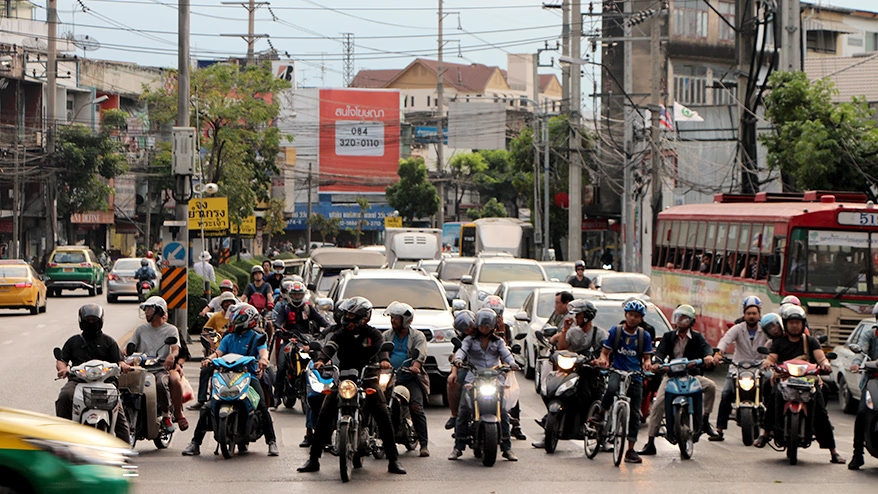こんにちは!モノサスタイランドの町山です。
タイに住み始めて早1年半、タイに来たばかりのころ新鮮に感じていたことにも、徐々に慣れつつある今日この頃。とはいえ、未だに不思議に感じることや、「ぇ!?」と驚くこと、カルチャーショックを受けることはまだまだあります!
そこで、そんなタイで暮らしていているからこそ感じるものごとを、わたしの思うタイあるあるという形でお届けしたいと思います。初回である今回は、交通事情にフォーカスしてご紹介します!少しでも、タイの一面をお楽しみいただければ幸いです。
困惑の交通編
タイに来る前、東南アジアと言われて浮かぶイメージのひとつに、すごい数の車やバイクが信号待ちで待機している場面がありました。タイへきてみると、実際あんな感じです。一般車の他に、タクシーやバイク、バスも多く走っているので交通量も排気ガスもすごいです。そんななかで感じる、タイの驚きの交通事情をご紹介します。
タクシー
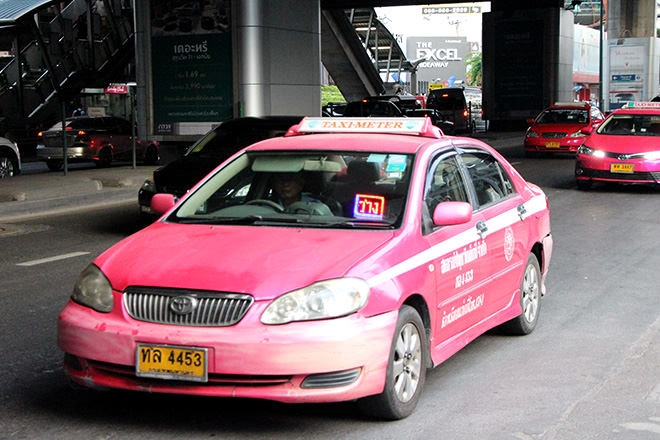
タイのタクシーはカラフルです。わたしが普段よく見かけるのはピンク・緑・黄色・
黄色と緑のツートンカラーです。他には青やピンク等々、少なくとも8種類はあるそうです。
ちなみに、黄色と緑のツートンカラーは個人タクシー、それ以外はタクシー会社のタクシーです。個人タクシーの方がサービスが悪い確率が高いという人もいますが、個人的にはそんなに変わらない気がします。
初乗りの安さ
タクシーは初乗り35バーツ=100円ちょっとです。これは、安すぎます…!街の中心地内で移動しようとすると、もちろん距離や混雑具合に比例はしますが大体40〜100バーツくらいでしょうか。日本でいう渋谷〜新宿間くらいの距離で、50〜60バーツくらい。日本円でいうと150〜200円です。おかげですっかりタクシーでの移動が増え、タイ在住の日本人は歩く機会が少なくなるという現象に陥りがち。わたしもそのうちの一人です…。
ある意味対等?乗車拒否
タイでは運転手の意思が日本よりも強めです。タクシーに乗る時は、乗客が自分の行き先をまず伝えて、そこに運転手が行くか行かないかを決める自由があります。OKなら首を縦に、NOなら首を横に振ります。ここで断られる確率は、個人的な体感としては30%くらいにはのぼると思います。そして、乗車拒否を伝える方法、理由もさまざまです。
曲がりたくない
目的地の距離は近い。5分以内。でも「今走っているこの道路から曲がりたくないから、ごめんね!」だそうです。
遠い
本当なら理解しやすいはずのこの理由。ですが運転手さんの気分や人によって、この「遠い」という距離にものすごく幅があります。なぜ断るかわからないくらい楽勝の距離、たった1駅ただまっすぐ行けばいいだけというレベルのこともあります。「あはっ、そんな遠いとこ行けないよー!(笑)」という感じで顔の前で無理無理って身振りをして去っていく…。じゃぁなんで空車の赤いランプを点灯させているのかと問いたい。一体誰なら乗せるんだ!!
そもそも止まらない
空車を示す赤いランプを確認。手を挙げて待機。タクシーが私の目の前を、こちらがいないかのようなスピードで(むしろ加速?)全力でスルー。…そもそも止まらない問題はおそらく一番多いのではないでしょうか。じゃぁ何故赤いランプを点け…いつも同じ心持ちです。はじめはイライラしていましたが、今ではよくありすぎて慣れてしまいました。
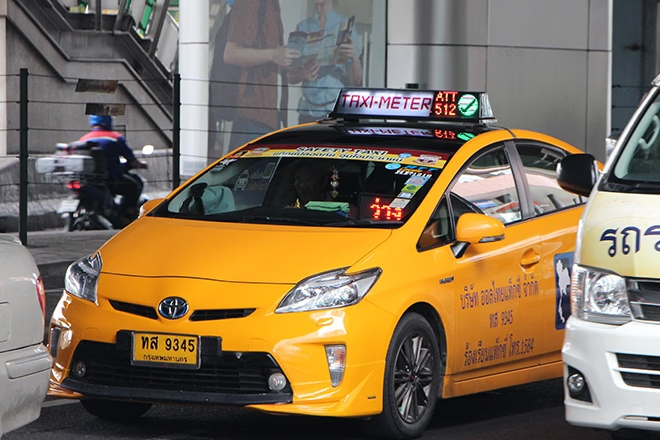
黄色いタクシーは乗車拒否しないということが売りの、サービスがよいタクシーのはずなんですが、なぜか黄色に乗車拒否されたこともあります!
100バーツ
タクシーを止めて行き先を伝えると、「100バーツ」と言われることがあります。これは、こちらが乗る前から「メーターを使わない宣言」をしていることになるので、完全にふっかけてきています。現地に住んでいればほぼないですが、それでも観光客の多い場所や、大雨でタクシーを使う人が多い時には、稀に出くわします。皆さんももし旅行に来られたら、メーターを使う素振りを見せなかったら注意してください。それでも、日本円に換算するとまぁいいか〜と思えるレベルかもしれませんが!
地図はすべて頭の中
タイのタクシーは、一昔前に日本で走っていたと思われる中古車がほとんど。ナビはもちろん付いていません。乗車中、道に関する質問もよくされます。Uターンするんだよね?次の道を右折でいいんだよね?みたいに。たまに、運転手が道を間違えそうになったり、実際間違えることがあります。そんな時に、違う違う!この信号を右に曲がって!とこちらから道を案内しなければならない場面がちょこちょこ発生するため、あまりぼーっとして身を任せ切れません。自分でも常にMAPと現在地を表示しておいて、曲がるポイントが近くなったら、運転手がちゃんと曲がろうとしているかチェックすることは欠かせません。
おしゃべり大好き
わたしは、タクシーで道を誘導するくらいのタイ語はわかります。ですが会話を続けられるようなタイ語力はありません。タクシーに乗車中、急にタイ語で話しかけられ、行き先の質問をされたのかな?と思い「えっ?何ですか?」と身を乗り出すと、運転手は片耳にイヤホンを付けて誰かと電話しているご様子…。しかも楽しそうに爆笑しています。業務上のやり取りではないみたいです。こんな風に、運転手が業務中に個人的な電話でのやり取りをするのは日常茶飯事です。まぁ、安全運転さえしてくれればよいのですけれども!
ウーバー
日本でも一部地域では導入されているアプリサービス。ウーバーに登録した一般のドライバーが、都合の良い時にタクシーのように乗客を乗せてお小遣い稼ぎができるサービスです。ウーバーなら、乗客がアプリのMAP上でピンポイントで目的地の指定ができるため、わたしはタイ語で運転手さんに行き先を正確に伝える自信がない時に使います。
「どこ行くの?」
乗った瞬間、「どこ行くの?」と高確率で聞かれます。あれ?MAP上で指定したので運転手も知っているはず…というか相手のスマートフォン上にすでに目的地が表示されている(運転手の携帯の画面が後部座席から見える)。いやいや、地図出てるじゃんっ!お願いだから、その地図を見て…!!行き先を伝えるのが難しいから使っているのに、そんなこちらの都合はお構いなしです。
※追記
最近知ったのですが、ウーバーの運転手は配車を依頼した人の元に到着した時点で初めて目的地を知ることができるそうです。今までごめんなさい!それなら納得できます。それでもなるべく地図見てほしいけど…。このお決まりの流れで「空港に行きたい」と伝えたら「ジンロー!?(マジで!?)」と言われたこともあります。空港といっても30分くらいなんですけどね!
運転初心者
実はタイには、日本のような厳格な教習所がありません。そもそも教習所に通わなくとも、友だちや家族から運転を教わって、とにかく試験にさえ受かればOKらしいのです。(スタッフにも確認しましたが噂はほんとうのようでした…!)しかもその実技試験も3STEPしかなくて日本と比べるととても簡単。そのためタイの道路には、運転がかなり下手だったり、ものすごく荒かったり、とんでもなくスピードを飛ばすドライバーが本当に多いのです。一般道路なのに、混んでいなければ高速並に飛ばします。そしてこれまた怖いのが、高速道路での実練習も実試験ももちろんありません…。
ウーバーに話を戻します!ウーバーのドライバーとして登録できる基準は不明ですが、かなりの初心者でも登録できてしまうようです。これまで利用してきた中で、明らかに運転初心者の人に当たったことが何度かあり、Google mapばかりチラチラ見ていて逆に危ないので、乗ってる間こちらが道案内をするなんてこともたまにあります。
バイク
バイタク
運転手はしっかりヘルメット装着、客はノーヘル(ヘルメットなし)。これがタイでの通常運転です。その違和感に対して、当の運転手は何の疑問も抱いていなさそうなので逆に清々しい気もします。じゃぁせめて安全運転を心がける…訳でもないんです!むしろ本当に、彼らの運転は身の危険を感じさせます。
そもそも道もそんなによくないので、ボコボコしている中をものすごい勢いでぐんぐん加速し、しょっちゅう車線変更しながら縫うように他のバイクや車を追い越そうとします。もう十分スリルは味わいましたし、命を無下にしたくはないので、これからは極力乗らないと心に決めました。おまけですが、バイタクの運転手はGoProをヘルメットのてっぺんに付けている人が多いです。その映像をスリリングなものにするために飛ばしている人もいるのでしょうか…。
定員オーバー
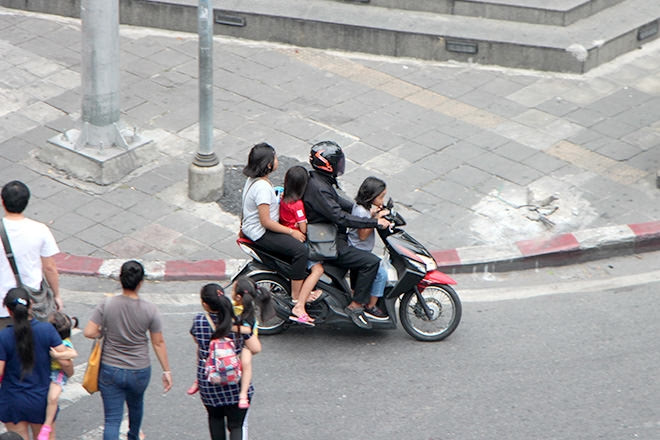
小さい子供を乗せてバイクで家族3人乗り、若い男女3人乗りはよく見かけます。MAXで家族5人乗りも街中で見かけたことがあります。
車の荷台
荷台に人が乗っていることが本当に多いです。荷物の見張り番ではなくとも。外は暑いですし日差しもあるので乗り心地はよくないと思いますが、ちょっと楽しそう。
人以外にもいろいろなものを乗せています。
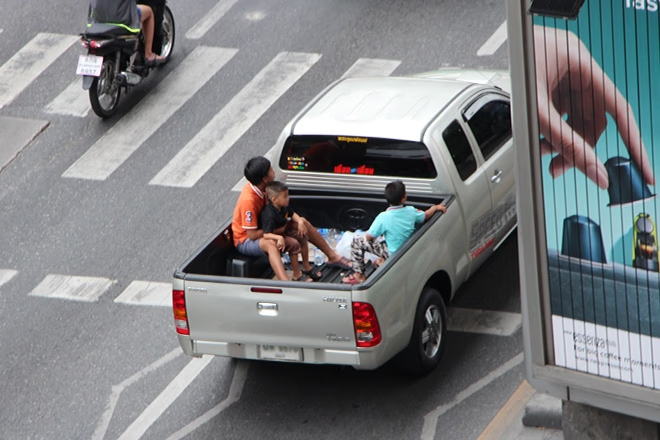

バイクに何でも固定する
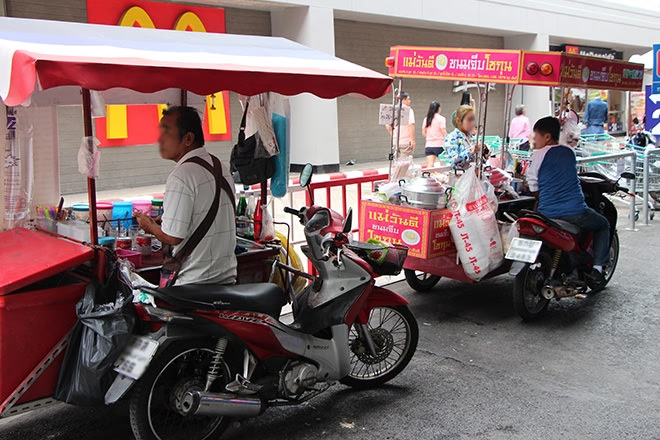
タイには露店が多く、店は毎日同じ位置に出すのですが、店の躯体はその場所に置きっ放しではありません。毎朝運んできて、毎晩どこかに持ち帰っているご様子。どうやってそれらを移動しているのかというと、屋台とバイクを固定し、普通にバイクを運転して道路を走っています。曲がるのが難しそうですし、危なくないのかな?とよく思いますが彼らにとってはこれが日常なのです。
電車
時刻表がない
時刻表はないですが、意外に一定の間隔で電車が来てくれます。基本的には大体5分おきくらい、長くて10分くらいでしょうか。
通勤ラッシュ
通勤時間はそれなりに混みます。それでも、もう限界を超えているところにさらに無理矢理人をぎゅうぎゅうと押し込んだりはタイ人はしません。日本人だと110%くらいまでは頑張って乗り込もうとしますが、タイ人は80-90%くらいの乗車率だったら次の電車を待とうとします。日本での通勤時間の人々は、何があっても遅れてはならない…!と鬼気迫る感じですが、タイではそんな感じは全く受けません。朝はストレスがなくてよいです!
エスカレーターがはやい
特に駅のエスカレーターが一番身近ですが、来たばかりの頃は、油断していると後ろにすてーんと転びそうになっていました。今では日本のエスカレーターの速度が物足りません。
駅構内、持ち込み禁止のポスター
ドリアンの匂いが強いため、持ち込みが禁止になっています。ピンポイントでポスターになっているので面白いです。※こちらも最近気付きましたが、ドリアンのシーズンのみ掲示される期間限定のポスターのようです。
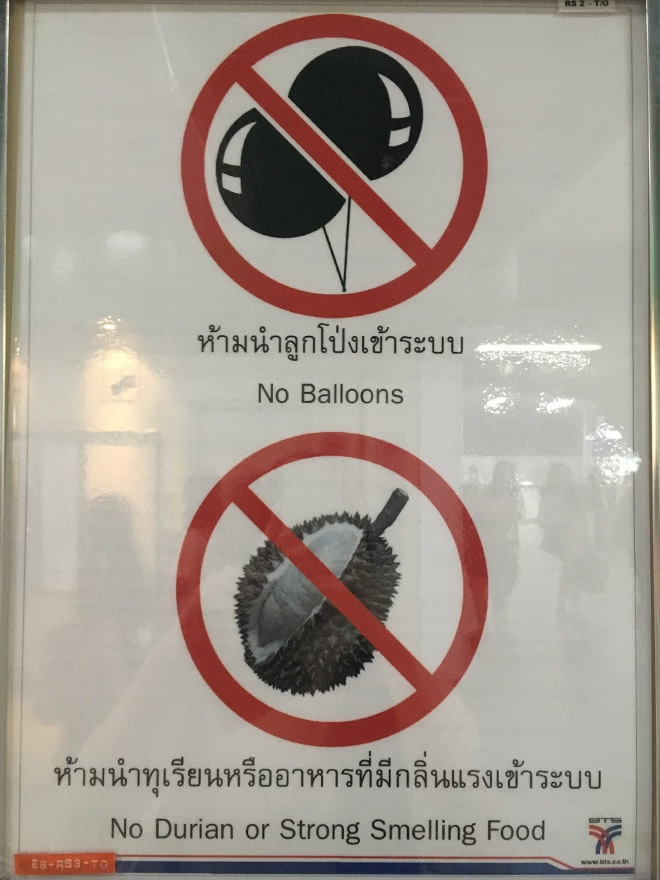
上のBalloonsは風船のこと。タイで風船を禁止するのは意外ですね!タイでたまーに見かける風船はまん丸で大きめのやつなので、単に邪魔だからですかね。
優先マーク
車内には、タイならではのこんなマークも。
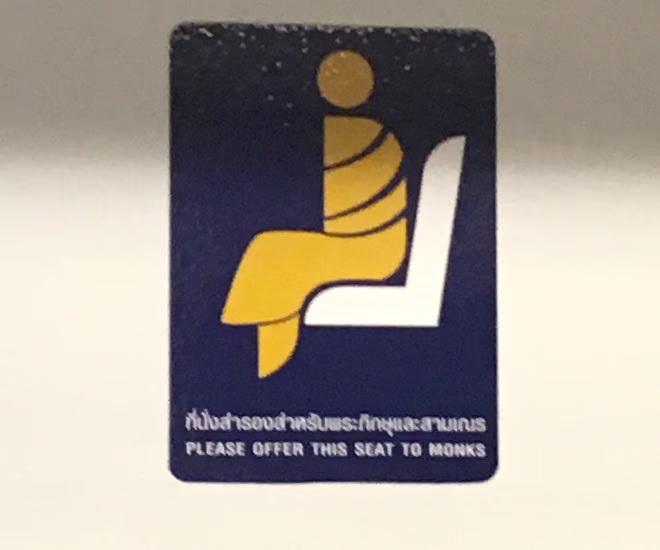
お坊さんを見かけたら、席をゆずりましょう!余談ですが、お坊さんに女性が触れてしまうと、それまでに積んだ徳が振り出しに戻ってしまうらしいので、女性はうっかり触れないようにしましょう。
日本とタイ、足して割ったらいいのかも?
いかがでしたか?今回は交通編にフォーカスしてお届けしました。ちょっと愚痴のような部分もあったかもしれませんがお許しください。日本と比べるとあまりに自由なタイですが、日本はちょっときっちりしすぎかなーと感じる部分もあります。日本にもタイのゆるさを少し取り入れたら、ちょうどよくなる気がしています。そしてタイはもう少しだけきっちりしてもいいかもしれませんね!一応取り締まりを厳しくしていこうとする動きはあるみたいです。
今後も、さまざまジャンルでタイあるあるをご紹介していけたらと思っています!
